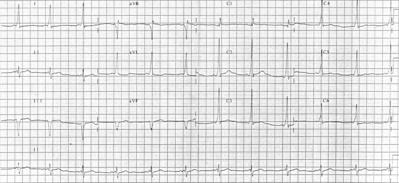Wolff-Parkinson-White syndrome
Wolff-Parkinson-White syndrome (WPW) is a syndrome of pre-excitation of the ventricles due to an accessory pathway known as the Bundle of Kent. This accessory pathway is an abnormal electrical communication from the atria to the ventricles. more...
The incidence of WPW syndrome is between 0.1 and 3 percent of the general population.,, While the vast majority of individuals with WPW syndrome remain asymptomatic throughout their entire lives, there is a risk of sudden death associate with WPW syndrome. Sudden death due to WPW syndrome is rare (incidence of ≤0.6%,), and is due to the effect of the accessory pathway on tachyarrhythmias in these individuals.
Pathophysiology
In normal individuals, electrical activity in the heart is initiated in the sinoatrial (SA) node (located in the right atrium), propagates to the atrioventricular (AV) node, and then through the bundle of His to the ventricles of the heart. (See electrical conduction system of the heart).
The AV node acts as a gatekeeper, limiting the electrical activity that reaches the ventricles of the heart. This is an important function of the AV node, because if the signals generated in the atria of the heart were to increase in rate (such as during atrial fibrillation or atrial flutter), the AV node will limit the electrical activity that conducts to the ventricles. For instance, if the atria are electrically activated at 300 beats per minute, half those electrical impulses are blocked by the AV node, so that the ventricles are activated at 150 beats per minute (giving a pulse of 150 beats per minute). Another important property of the AV node is that it slows down individual electrical impulses. This is manifest on the EKG as the PR interval, the time from activation of the atria (manifest as the P wave) and activation of the ventricles (manifest as the QRS complex).
Individuals with WPW syndrome have an accessory pathway that connects the atria and the ventricles, in addition to the AV node. This accessory pathway is known as the bundle of Kent. This accessory pathway does not share the rate-slowing properties of the AV node, and may conduct electrical activity at a significantly higher rate than the AV node. For instance, in the example above, if an individual had an atrial rate of 300 beats per minute, the accessory bundle may conduct all the electrical impulses from the atria to the ventricles, causing the ventricles to activate at 300 beats per minute. The ventricles are not capable of activating in a uniform manner at rates that fast and will fibrillate instead (ventricular fibrillation). If not corrected rapidly, ventricular fibrillation leads to sudden cardiac death (SCD).
Read more at Wikipedia.org


